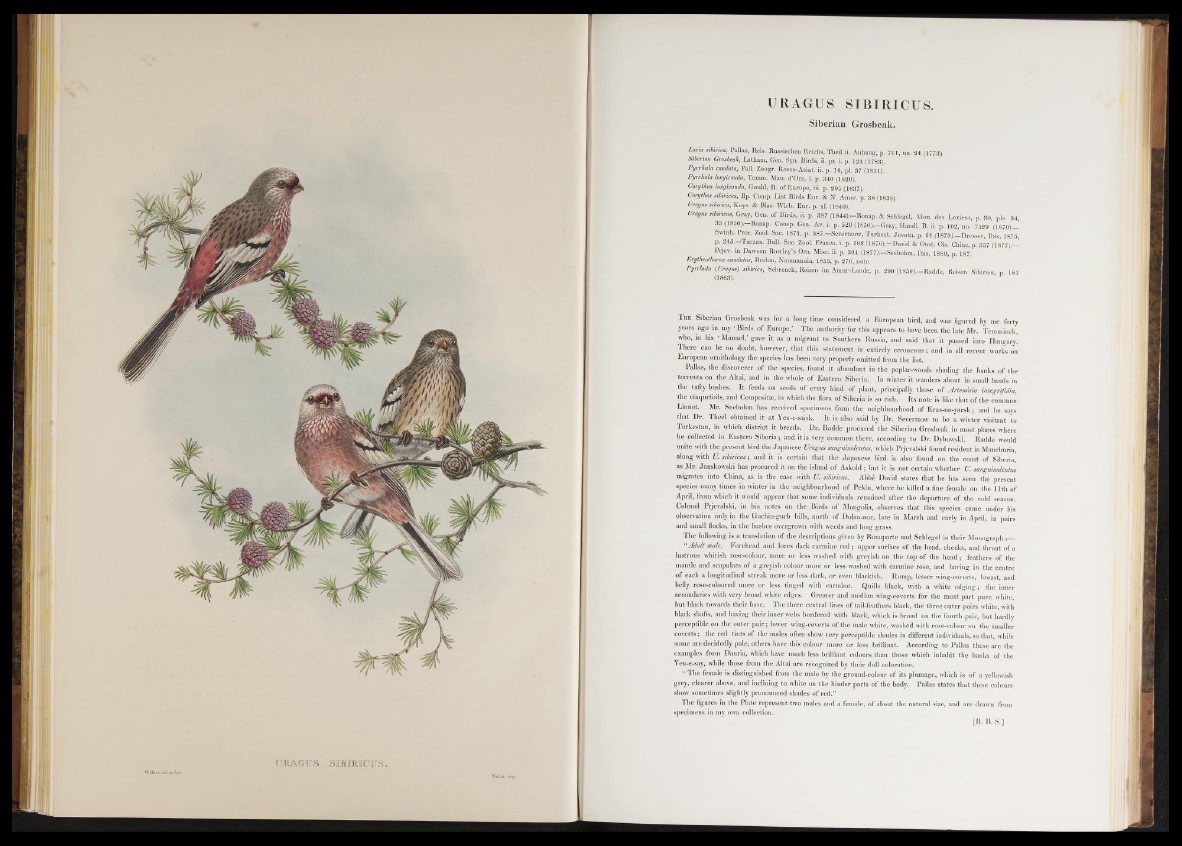
URAGUS SIBIRICUS,
Siberian Grosbeak.
Loxia sibirica, Pallas, Reis. Russischen Reichs, Theil ii. Anhang, p. 711, no. 24 (1773).
Siberian Grosbeak, Latham, Gen. Syn. Birds, ii. pt. i. p. 124 (1783).
Pyrrhula caudata, Pall. Zoogr. Rosso-Asiat. ii. p. 10, pi. 37 (1811)
Pyrrhula longicauda, Temm. Man. d’Orn. i. p. 340 (1820)1
Cory thus longicauda, Gould, B. o f Europe, iii. p. 205 (1837).
Corythus sibiricus, Bp. Comp. L is t Birds Eur. & N. Amer. p. 38 (1838).
Uragus sibirica, Keys. & Blas. Wirb. E ur. p. xl. (1840).
Uragm Gray, Gen. of B i r d s , g p . 387 (1844).-Bonap. & Schlegel, Mon. des Loriens, p. 30, pis. 34,
35 (1850).—Bonap. Consp. Gen. A t. i. p. 529 (1850))—Gray, Handl. B. ii. p. 102, no. 7529 (1870) —
Swinh. Eroc. Zool. Soc. 1871, p. 337.—Severtaow, Turkest. Jevotn. p. 64 (1873).—Dresser, Ibis, 1875,
p. 245— Taczan. Bull. Soc. Zool. France, i. p. 1 8 2 & 6 ) - D a v i d & Oust. Ois, Chine, p. 357 (1877).—
Pijev. in Dawson Rowley's Om. Misci,,» p. 304 (1877).—S e e h 6 h% Ip g | 1880, p. 187.
Erythrothorax caudatus, Brehm, Naumannia, 1855, p. 276, note.
Pyrrhula ( Uragus) sibirica, Schrenck, Reisen im Amur-Lande, p. 290 (1859).—Radde, Reisen Sibirien, p 181
(1863),
T h e Siberian Grosbeak was for a long time considered a European bird, and was figured by me forty
years ago in my ‘Birds o f Europe.’ The authority for this appears to have been the late Mr. Temminck,
who, in his ‘Manuel,’ gave it as a migrant to Southern Russia, and said that it passed into Hungary!
There can be no doubt, however, that this statement is entirely erroneous; and in all recent works on
European ornithology the species has been very properly omitted from the list.
Pallas, the discoverer o f the species, found it abundant in the poplar-woods shading the banks of the
torrents on the Altai, and in the whole of Eastern Siberia. In winter it wanders about in small bands in
the tufty bushes. I t feeds on seeds of every kind o f plant, principally those o f Artemisia integrifolia,
the cinquefoils, and Composite, in which the flora o f Siberia is so rich. Its note is like that of the common
Linnet. Mr. Seebohm has received specimens from the neighbourhood of Kras-no-yarsk; and he says
that Dr. Theel obtained it at Yen-e-saisk. I t is also said by Dr. Severtzow to be a winter visitant to
Turkestan, in which district it breeds. Dr. Radde procured the Siberian Grosbeak in most places where
he collected in Eastern Siberia; and it is very common there, according to Dr. Dybowski. Radde would
unite with the present bird the Japanese Uragus sanguinolentas, which Prjevalski found resident in Manchuria,
along with U. sibiricus; and it is certain th at the Japanese bird is also found on the coast of Siberia!
as Mr. Janskowski has procured it on the island of Askold ; but it is not certain whether U sanguinolentas
migrates into China, as is the case with U. sibiricus. Abbé David states that he has seen the present
species many times in winter in the neighbourhood o f Pekin, where he killed a fine female on the 11th of
April, from which it would appear that some individuals remained after the departure of the cold season.
Colonel Pijevalski, in his notes on the Birds of Mongolia, observes that this species came under his
observation only in the Guchin-gurb hills, north o f Dolan-nor, late in March and early in April, in pairs
and small flocks, in the bushes overgrown with weeds and long grass.
The following is a translation of the descriptions given by Bonaparte and Schlegel in their Monograph :__
“Adult male. Forehead and lores dark carmine r e d ; upper surface o f the head, cheeks, and throat of a
lustrous whitish rose-colour, more or less washed with greyish on the top of the h e a d ; feathers of the
mantle and scapulars o f a greyish colour more or less washed with carmine rose, and having in the centre
of each a longitudinal streak more or less dark, or even blackish. Rump, lesser wing-coverts, breast, and
belly rose-coloured more or less tinged with carmine. Quills black, with a white edging; the inner
secondaries with very broad white edges. Greater and median wing-coverts for the most part pure white,
but black towards their base. The three central lines of tail-feathers black, the three outer pairs white, with
black shafts, and having their inner webs bordered with black, which is broad on the fourth pair, but hardly
perceptible on the outer p a ir ; lower wing-coverts o f the male white, washed with rose-colour on the smaller
coverts; the red tints of the males often show very perceptible shades in different individuals, so that, while
some are decidedly pale, others have this colour more or less brilliant. According to Pallas these are the
examples from Dauria, which have much less brilliant colours than those which inhabit the banks o f the
Yen-e-say, while those from the Altai are recognized by their dull coloration.
“ The female is distinguished from the male by the ground-colour of its plumage, which is o f a yellowish
grey, clearer above, and inclining to white on the hinder parts of the body. Pallas states that these colours
show sometimes slightly pronounced shades of red.”
The figures in the Plate represent two males and a female, of about the natural size, and are drawn from
specimens in my own collection.
[R. B. S.]